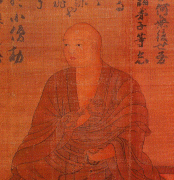 Kukai, original name SAEKI
MAO, posthumous name KOBO DAISHI (b. July 27, 774, Byobugaura [modern
Zentsuji], Japan--d. April 22, 835, Mount Koya, near modern
Wakayama), one of the best known and most beloved Buddhist saints in
Japan, founder of the Shingon ("True Word") school of Buddhism that
emphasizes spells, magic formulas, ceremonials, and masses for the
dead. He contributed greatly to the development of Japanese art and
literature and pioneered in public education.
Kukai, original name SAEKI
MAO, posthumous name KOBO DAISHI (b. July 27, 774, Byobugaura [modern
Zentsuji], Japan--d. April 22, 835, Mount Koya, near modern
Wakayama), one of the best known and most beloved Buddhist saints in
Japan, founder of the Shingon ("True Word") school of Buddhism that
emphasizes spells, magic formulas, ceremonials, and masses for the
dead. He contributed greatly to the development of Japanese art and
literature and pioneered in public education.
Kukai was born into an aristocratic family and as a youth was trained in the Confucian Classics. In 791, at the age of 17, he is said to have completed his first major work, the Sango shiiki ("Essentials of the Three Teachings"), in which he proclaimed the superiority of Buddhism over Confucianism and Taoism. Buddhism, he wrote, contained everything that was worthwhile in the other two beliefs, and it also showed more concern than either for man's existence after death. Desiring to learn more about Buddhism, Kukai went to China in 804. In the T'ang-dynasty capital of Ch'ang-an, he met the great master of esoteric Buddhism, Hui-kuo (746-805; Japanese: Keika), and became the master's favourite disciple, receiving his secret teachings when he lay dying. Returning to Japan in 806, Kukai was given imperial sanction to promulgate his new doctrines. In 816 he began building a monastery on Mount Koya, in west-central Japan. This grew into one of the largest and most vigorous monastic complexes in the country, and the Shingon sect became one of the most popular forms of Japanese Buddhism.
Besides his role as philosopher and religious leader, Kukai was also a poet, an artist, and a calligrapher. He exerted a great influence on the development of Japanese religious art over the next two centuries. In fact, much of the art that survives from this period depicts Shingon Buddhist deities. His major work, the Juju shinron ("The Ten Stages of Consciousness"), written in Chinese in a poetic style, classified Confucianism, Taoism, and all the existing Buddhist literature into 10 stages, the last and highest stage being that of Shingon philosophy. This work assured Kukai a leading rank among the intellectual figures of Japanese Buddhism.
BIBLIOGRAPHY.
Yoshito S. Hakeda (trans.), Kukai: Major Works (1972), includes essays on Kukai's life and thought.
